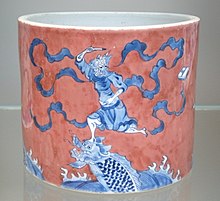
The Chinese Dragon, also known as the loong, long or lung, is a legendary creature in Chinese mythology, Chinese folklore, and Chinese culture at large. Chinese dragons have many animal-like forms such as turtles and fish, but are most commonly depicted as snake-like with four legs. Academicians have identified four reliable theories on the origin of the Chinese dragon: snakes, Chinese alligators, thunder worship and nature worship. They traditionally symbolize potent and auspicious powers, particularly control over water.

Chinese mythology is mythology that has been passed down in oral form or recorded in literature throughout the area now known as Greater China. Chinese mythology encompasses a diverse array of myths derived from regional and cultural traditions. Populated with engaging narratives featuring extraordinary individuals and beings endowed with magical powers, these stories often unfold in fantastical mythological realms or historical epochs. Similar to numerous other mythologies, Chinese mythology has historically been regarded, at least partially, as a factual record of the past.

Urashima Tarō is the protagonist of a Japanese fairy tale, who, in a typical modern version, is a fisherman rewarded for rescuing a turtle, and carried on its back to the Dragon Palace (Ryūgū-jō) beneath the sea. There, he is entertained by the princess Otohime as a reward. He spends what he believes to be several days with the princess. But when he returns to his home village, he discovers he has been gone for at least 100 years. When he opens the forbidden jewelled box (tamatebako), given to him by Otohime on his departure, he turns into an old man.
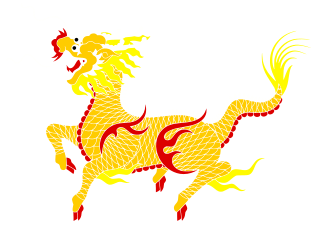
The qilin is a legendary hooved chimerical creature that appears in Chinese mythology, and is said to appear with the imminent arrival or passing of a sage or illustrious ruler. Qilin are a specific type of the lin mythological family of one-horned beasts. The qilin also appears in the mythologies of other Chinese-influenced cultures.

Osmanthus fragrans, variously known as sweet osmanthus, sweet olive, tea olive, and fragrant olive, is a species native to Asia from the Himalayas through the provinces of Guizhou, Sichuan and Yunnan in Mainland China, Taiwan, southern Japan and Southeast Asia as far south as Cambodia and Thailand.

The Black Tortoise is one of the Four Symbols of the Chinese constellations. It is usually depicted as a tortoise intertwined with a snake. The pictogram '武' can mean 'martial' or 'warrior.' The two characters 玄 and 武 do not have any literal meaning of tortoise and snake. But both tortoise and snake are known to hibernate during winter. The image of intertwined tortoise and snake likely symbolizes a state of inner struggle or a state of hibernation, and thus implies the season of winter. So the English translation Black ~ Dark ~ Mysterious Warrior is a more faithful translation.

Chinese jade refers to the jade mined or carved in China from the Neolithic onward. It is the primary hardstone of Chinese sculpture. Although deep and bright green jadeite is better known in Europe, for most of China's history, jade has come in a variety of colors and white "mutton-fat" nephrite was the most highly praised and prized. Native sources in Henan and along the Yangtze were exploited since prehistoric times and have largely been exhausted; most Chinese jade today is extracted from the northwestern province of Xinjiang.
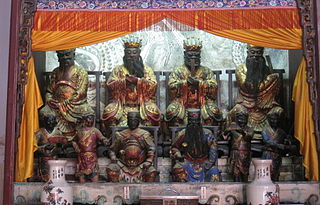
Ao Run (敖闰) or Ao Ji (敖吉), is the Dragon King of the West Sea and one of the Dragon Kings of the Four Seas in Chinese religion and Korean mythology. As an important belief in Chinese folk religion, Four Dragon King Temples are built around the place to worship the Dragon Kings.
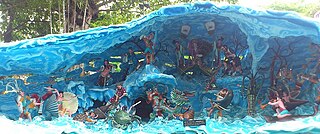
Ao Guang is the Dragon King of the East Sea in Chinese folklore. He featured prominently in different works including Fengshen Yanyi and Journey to the West.

Turtles are frequently depicted in popular culture as easygoing, patient, and wise creatures. Due to their long lifespan, slow movement, sturdiness, and wrinkled appearance, they are an emblem of longevity and stability in many cultures around the world. Turtles are regularly incorporated into human culture, with painters, photographers, poets, songwriters, and sculptors using them as subjects. They have an important role in mythologies around the world, and are often implicated in creation myths regarding the origin of the Earth. Sea turtles are a charismatic megafauna and are used as symbols of the marine environment and environmentalism.

The World Turtle, also called the Cosmic Turtle or the World-bearing Turtle, is a mytheme of a giant turtle supporting or containing the world. It occurs in Hindu mythology, Chinese mythology, and the mythologies of some of the indigenous peoples of the Americas. The comparative mythology of the World-Tortoise discussed by Edward Burnett Tylor (1878:341) includes the counterpart World Elephant.

Bixi, or Bi Xi, is a figure from Chinese mythology. One of the nine sons of the Dragon King, he is depicted as a dragon with the shell of a turtle. Stone sculptures of Bixi have been used in Chinese culture for centuries as a decorative plinth for commemorative steles and tablets, particularly in the funerary complexes of its later emperors and to commemorate important events, such as an imperial visit or the anniversary of a World War II victory. They are also used at the bases of bridges and archways. Sculptures of Bixi are traditionally rubbed for good luck, which can cause conservation issues. They can be found throughout East Asia and the Russian Far East.

The Harvard Bixi is a 17-foot high, 27 ton Chinese marble stele with a turtle pedestal located at Harvard University, north of Boylston Hall and west of Widener Library in Harvard Yard, in Cambridge, Massachusetts. The stele was presented to the university by the Chinese Harvard Alumni for its Tercentenary in September 1936.

Turtleback or Turtle-back tombs or turtle shell tombs are a particular type of tombs originating from the Song Dynasty. They are commonly found in some coastal provinces of southern China, the Ryukyu Islands of Japan, and in Vietnam. They can also be found in countries with overseas Chinese populations like Malaysia.
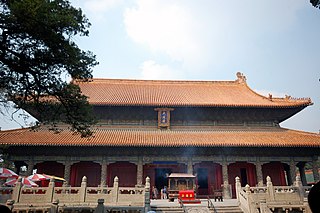
The Temple of Confucius in Qufu, Shandong Province, is the largest and most renowned temple of Confucius in East Asia.

The nine sons of the dragon are Chinese dragons who are the mythological sons of the Dragon King. There are many variations in the different descriptions of the nine sons, including in basic facts like their names, but all versions state that there are nine.

The East Zhejiang Maritime Affairs/Folk Custom Museum is a museum located in Yinzhou District in Ningbo, Zhejiang, China. It is located in the Qing'an Guildhall, a reconstructed complex which once housed a temple to the sea-goddess Mazu. Originally built in 1191, the complex was destroyed and rebuilt several times. After its mid-19th century restoration by Ningbo's guild of Fujianese merchants, it was acclaimed as one of the most beautiful temples in China and was used by the merchants as their guildhall. It was destroyed in 1949 as the Communists were fighting the Chinese Civil War, and suffered further harm during the Cultural Revolution, but was repaired from 1997 to 2001. It reopened in June 2001 as a museum dedicated to eastern Zhejiang's maritime history and local arts and crafts.
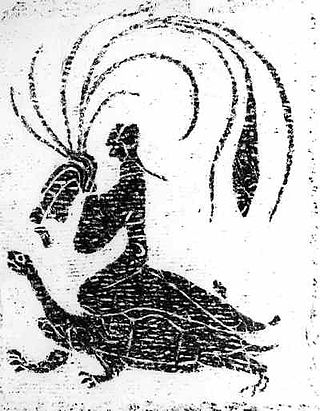
The spirit turtle or spirit tortoise is a turtle originated from Chinese mythology and spread with East Asian cultural sphere. It is believed by East Asian cultures, like other turtles in mythology, to represent longevity (壽命).

Longgang is a county-level city of Zhejiang, China. As of 2018, its population was 378,000, spread across 183.99 km2 (71.04 sq mi) divided into 14 neighborhoods, 22 residential areas, and 171 villages. Longgang is administered as a part of the prefecture-level city of Wenzhou, whose downtown is about 70 kilometers (43 mi) away.
